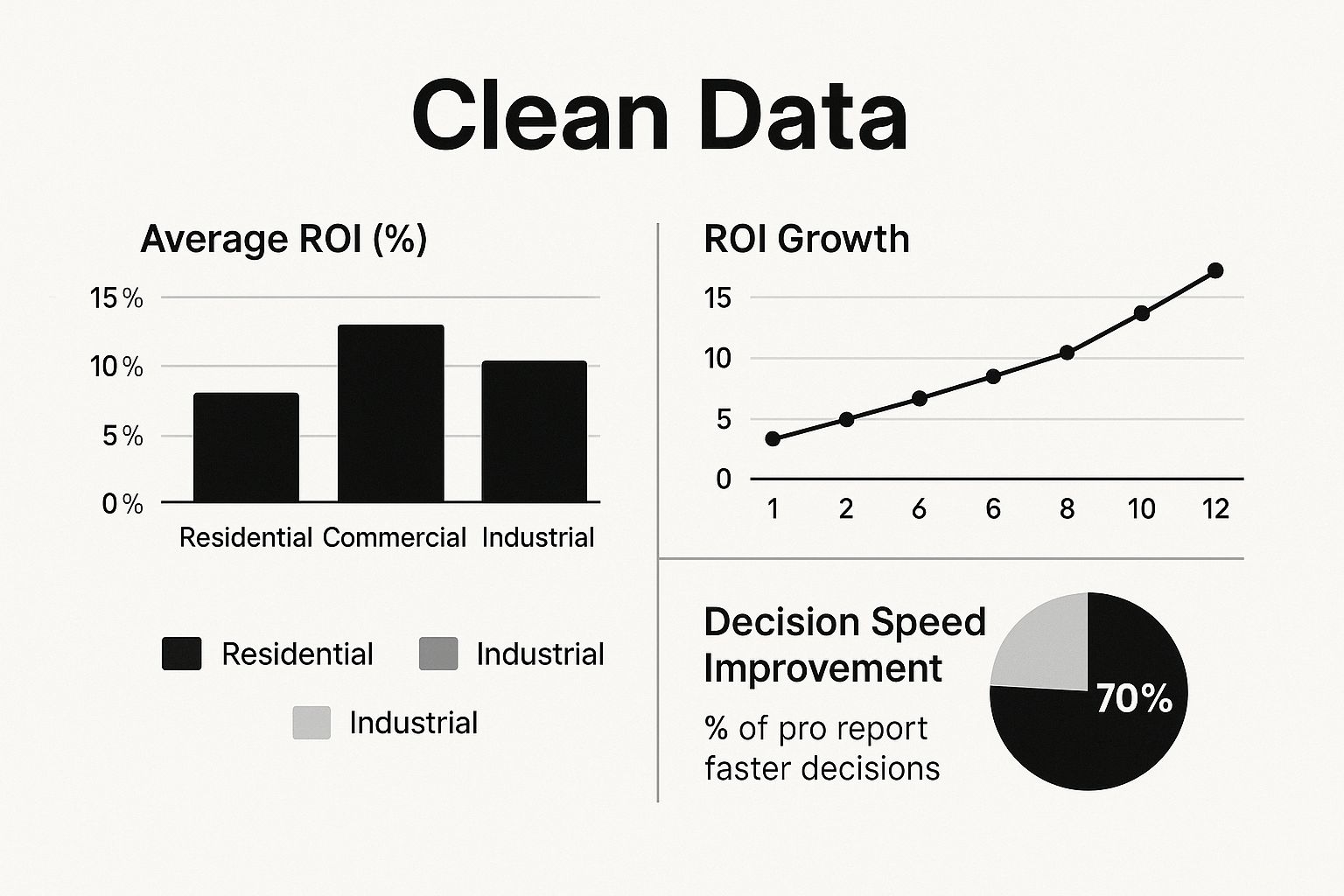For years, a savvy real estate pro’s best tool was their gut. But trying to navigate today’s fast-paced, complex market on intuition alone is like sailing in a storm without a compass. The most successful investors are now pairing their hard-won experience with a data-driven GPS, giving them a crystal-clear view of the landscape.
This shift is more than just a trend. When you base your decisions on hard numbers, you gain the transparency needed to measure your potential Return on Investment (ROI) with incredible precision.
Move Beyond Guesswork in Real Estate Investing

Relying on a hunch is a massive gamble in the modern property market. The sheer volume of information and the speed at which things change mean that a decision based on incomplete data—or worse, an emotional whim—can be costly. You might overpay for a property or sink your capital into an asset with hidden problems that drain your finances.
The solution is to build your strategy on a foundation of data. This doesn’t mean ignoring your professional judgment; it means supercharging it with objective facts. It’s about swapping assumptions for verifiable metrics. Instead of just feeling like a neighborhood is on the rise, you analyze demographic trends, track rental demand, and study historical appreciation rates.
The Power of Clarity and Verifiable Data
The real magic of this approach is the clarity it brings. When you can see every financial piece of the puzzle—from the acquisition price and estimated operating costs to market comps and realistic income projections—you can build a financial model you can actually trust. This process tells you the real story behind a listing, not just the sales pitch.
By making data the foundation of your strategy, you transform investing from an art of guesswork into a science of wealth creation. This transparency is the only way to confidently identify profitable opportunities and sidestep the ones that only look good on the surface.
This disciplined, analytical approach is essential for anyone serious about building a strong portfolio. When you commit to data-driven decision-making, that transparency is what allows you to accurately measure ROI. Ultimately, it’s about making smarter, more predictable choices that protect your capital and generate sustainable growth.
What Data-Driven Decision-Making Means for You

So, what does being “data-driven” actually look like on a typical Tuesday afternoon when you’re staring down a potential duplex investment? In short, it’s about swapping vague feelings for cold, hard numbers. It’s the process of putting together a high-definition picture of a property’s future using specific, verifiable information.
Instead of just getting a good vibe from a neighborhood, you dive into the numbers that tell its real story. You’re looking at micro-market trends, recent comps, and demographic shifts to understand who is moving in and why. This kind of systematic approach pushes aside the personal biases and emotional attachments that can so often derail a sound investment.
The Foundation of Smart Investment
The whole point is to build a strategy on a solid foundation of data. Think of it as a checklist you run through to find the financial truth hidden behind an attractive listing.
Key data points you absolutely should be gathering include:
- Property Performance History: Getting your hands on past rental income, vacancy rates, and maintenance logs gives you a realistic baseline for your own projections.
- Micro-Market Trends: Digging into local job growth, school ratings, and any new infrastructure projects helps you predict future demand with much greater accuracy.
- Demographic Shifts: Watching how population, income levels, and household sizes are changing can be a huge tell for spotting emerging opportunities before everyone else does.
This 360-degree view uncovers the financial reality of a deal—separating a genuine opportunity from a potential money pit. Market conditions are a massive factor, especially in commercial real estate. For instance, recent analyses show that open-air shopping centers can lead with unlevered property price returns of 3.4%, easily outpacing struggling office spaces. You can explore more about commercial real estate drivers and how they affect returns.
When you let data drive your decisions, you’re not just buying a property; you’re investing in a predictable financial asset. That transparency is what allows you to measure ROI with real confidence because every assumption is backed by solid proof.
By grounding your strategy in these core metrics, you stop speculating and start calculating. You can forecast cash flow more accurately, anticipate expenses, and ultimately build a portfolio that’s designed for reliable, long-term growth.
How Investment Transparency Unlocks Accurate ROI

When it comes to calculating a reliable ROI, transparency isn’t just a nice-to-have—it’s the foundation of the entire process. Without it, you’re not making projections; you’re just guessing.
Think of it like trying to navigate a new city without a map. You might get lucky, but you’re far more likely to get lost. In real estate, this means having clear, undeniable data for every dollar in and every dollar out. This moves your analysis from a hopeful assumption to a solid financial model.
The Difference Between Clarity and a Gamble
Let’s look at a classic real-world scenario. You’re comparing two duplexes that, on the surface, seem identical. They’re in the same neighborhood and have similar layouts. But the story changes when you look at the books.
- Property A comes with an open book. You get detailed maintenance logs, verified rental payment histories from every tenant, and a clear breakdown of property taxes and insurance. This clarity lets you build an ROI projection you can actually trust.
- Property B is a black box. The seller gives you vague utility “estimates,” has no real maintenance records to show, and offers an incomplete rent roll. This lack of transparency is a huge red flag, hiding potential money pits like a dying HVAC system or problem tenants.
With Property A, data-driven decision-making is not only possible, it’s straightforward. The numbers tell the true story. For Property B, you’re essentially being asked to invest blind, making any ROI calculation pure fiction.
True investment transparency isn’t just about showing off the good numbers. It’s about having access to the complete financial picture—the good, the bad, and the ugly. It’s the only way to protect your capital and make decisions with real confidence.
Ultimately, a commitment to data transparency ensures your ROI is a metric grounded in reality, not just wishful thinking. A solid return for a rental property typically falls in the 8% to 12% range, and having precise data is the only way to know if you’re hitting that mark.
For more guidance on this topic, you can also check out our article on how to improve your marketing ROI.
See the Full Picture with Advanced Metrics
Relying on a single Return on Investment (ROI) percentage is a bit like judging a car’s performance just by its top speed. It’s an important number, no doubt, but it hardly tells the whole story. To get a real feel for a property’s financial health, you need to look at a whole dashboard of metrics—and that only becomes possible when you have complete data transparency.
This bigger picture moves you beyond a simple profit calculation and into a more nuanced understanding of how an asset is truly performing. Think of it as the difference between a blurry photo and a crystal-clear, high-resolution image. When all the data is on the table, it unlocks data-driven decision-making and allows you to measure ROI in its full, meaningful context.
Going Beyond a Single Percentage
So, how do you build that robust financial picture? Smart investors I know track several key indicators side-by-side. Each one reveals a different facet of the property’s financial story, and together, they give you a much stronger foundation for making sound decisions.
Two of the most important ones to start with are:
- Net Operating Income (NOI): This shows you a property’s profitability before you factor in financing costs and taxes. It’s a pure, clean measure of how well the asset itself generates income from its day-to-day operations.
- Cash-on-Cash Return: This metric gets straight to the point. It calculates the actual cash income you’re earning against the cash you personally invested. It’s a powerful gut check for how hard your capital is working for you.
This image really drives home how seeing different data points together—from comparative ROI to how fast you can make a decision—creates a much more complete picture.

As you can see, the data doesn’t just show how different property types perform; it also reveals how much faster professionals can act when they have clear insights at their fingertips.
Of course, the list doesn’t stop there. Metrics like Gross Operating Income (GOI), which is your total revenue before any expenses are taken out, and Annual Average Return (AAR) are also critical pieces of the puzzle. The more metrics you’re familiar with, the better your analysis will be.
To help you get a handle on these, here’s a quick reference table.
Essential Real Estate Investment Metrics at a Glance
| Metric | What It Measures | Simplified Formula | Why It Matters |
|---|---|---|---|
| ROI | Overall profitability of an investment | (Net Profit / Total Investment Cost) x 100 | The classic “big picture” metric, but can be misleading on its own. |
| NOI | A property’s income-generating ability from operations | Gross Operating Income – Operating Expenses | Gives a clean look at performance before debt and taxes are considered. |
| Cash-on-Cash Return | Rate of return on the actual cash invested | (Annual Pre-Tax Cash Flow / Total Cash Invested) x 100 | Tells you how effectively your out-of-pocket cash is generating returns. |
| Cap Rate | The rate of return on a real estate investment property based on the income that the property is expected to generate | Net Operating Income / Current Market Value | Helps you quickly compare the potential return of similar properties. |
By tracking these metrics, you can start building a far more durable and reliable understanding of any investment.
Ultimately, looking at these indicators together stops you from being fooled by a single, flattering number. A property might boast a decent ROI but suffer from a weak cash-on-cash return, signaling potential cash flow problems down the line.
Understanding these distinctions is key. It’s just as crucial as grasping the details of your marketing efforts, like how pay-per-click advertising, when done right, can be a game-changer for lead generation.
Putting Your Data Strategy into Action
Let’s get practical. Moving from theory to real-world results is where the rubber meets the road. Getting started with a data-first approach isn’t about becoming a statistician overnight. It’s about committing to a new way of working and finding the right tools for the job. Your main objective is to build a system that consistently gives you information you can trust.
Today’s real estate toolkit is loaded with platforms built for this very purpose. Many property management systems, for instance, now come with surprisingly powerful analytics dashboards right out of the box. These tools can automatically track everything from rent collection and vacancy rates to maintenance costs, translating messy numbers into clean, understandable reports.
And it doesn’t stop there. Specialized market analysis platforms can give you a deep dive into neighborhood trends, demographic shifts, and even predictive forecasts. They pull together massive amounts of public and private data, giving you a serious advantage in spotting opportunities before everyone else does.
It All Starts With Reliable Data
Of course, any tool is only as good as the information you feed it. This is why having a clear process for collecting and verifying your data is absolutely critical. The old saying holds true: garbage in, garbage out.
To keep your data clean and reliable, you need a disciplined system.
- Gather Consistently: Use the same templates to collect information on every single property you analyze. This is the only way to ensure you’re comparing apples to apples.
- Clean and Verify: Never take data at face value. You need to cross-reference rent rolls with actual bank statements and dig into any “estimated” expenses. A few phone calls can often uncover mistakes that save you thousands.
- Centralize Everything: Store your data in a single, central system. It could be a sophisticated Integrated Workplace Management System (IWMS) or even a meticulously organized spreadsheet. The goal is to create one undisputed source of truth for your entire portfolio. To learn more about setting this up, check out our guide to building a data-driven marketing strategy.
Case Study: A Firm’s Data-First Turnaround
I once worked with a mid-sized real estate firm that ran entirely on the partners’ decades of experience. They were successful, but their growth had completely flatlined. They kept missing out on deals in up-and-coming areas because they just couldn’t analyze them quickly enough.
They decided to make a change and adopt a data-first culture. They invested in an analytics platform and, more importantly, trained their team to trust the numbers over their gut instincts. The results were stunning.
Within 18 months, they used their new process to identify and buy a portfolio of undervalued multifamily properties in a neighboring state—a market they would have completely ignored before. This commitment to allowing for data-driven decision-making and demanding total financial transparency enables real estate professionals to measure ROI with incredible accuracy. For them, it led to a 22% jump in their overall portfolio value.
The Future Is Data-Driven Real Estate
Looking ahead, data isn’t just a helpful tool in real estate anymore; it’s quickly becoming the bedrock of a successful and long-lasting career. The era of gut feelings and pure intuition is winding down. True success now hinges on your ability to read the story the data tells and make smart moves based on what it says. When it comes to investing, that kind of transparency isn’t just nice to have—it’s essential for any kind of sustainable growth.
This change is only getting faster thanks to new technologies. Tools like artificial intelligence (AI) and predictive analytics are poised to completely reshape how we work, giving us an incredible window into what the market might do next. These systems can sift through thousands of data points, everything from population changes to economic trends, to predict future property values and pinpoint hot markets before they even hit the mainstream radar.
The real takeaway here is about empowerment. When you embrace this shift, you start treating data as your most valuable asset. It’s the key to building a smarter, more predictable, and ultimately more profitable portfolio.
Making decisions based on solid data is no longer a choice—it’s a requirement. This transparency enables real estate professionals to measure ROI with a precision that was once out of reach. By weaving these practices into your work, you’re not just adapting to a trend. You’re actively building a more secure and prosperous future for yourself in this industry.
Your Questions Answered: Getting Started with Data-Driven ROI
I’m completely new to this. How do I even begin using data?
Don’t try to boil the ocean. The best way to start is to pick one thing and track it well. Think about a single, crucial area—maybe it’s your property operating expenses or the going rental rates in a specific neighborhood.
Even a simple spreadsheet is a fantastic starting point. Pit your actual income against what you projected. That single action is your first real step from guessing to making genuinely informed investment decisions.
Where do I actually find good, reliable real estate data?
Great data is out there, but you often have to look in a few places. Public records are a goldmine for things like tax assessments and sales history. For a deeper dive, subscription platforms can give you powerful market analytics, demographic shifts, and detailed rent comparisons.
The real pro move? Never trust just one source. Always cross-reference your information from a few different places to make sure it’s accurate before you put your money on the line.
At the end of the day, a successful portfolio is built by consistently making data-driven decisions. This commitment to transparency is what allows you to measure ROI with real accuracy, transforming speculation into a predictable strategy for growth.





